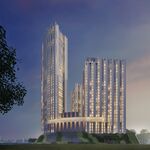So Eglinton is going to go from 10 metre buses to 90 metre underground trains and be full from day one, sure.
Length is irrelevant, what is relevant is passenger capacity.
Each Flexity can fit around 120 passengers before dwell times are affected (See the streetcar network)
Each 40' bus can fit around 40 passengers before dwell times are affected.
With 2 LRVs travelling down eglinton every 3 minutes, you're looking at a optimal capacity of 240 passengers every 4 minutes, or a capacity of 3,600 PPHPD, and that's assuming bunching isn't affecting your frequencies, or that people will evenly distribute themselves between trains shortturning at Laird and those going to Kennedy (spoilers: they won't).
Compare this to the existing capacities provided pre-COVID. I don't remember the exact frequencies but if I recall correctly it was somewhere close to a bus every 2 minutes on the west side, and a bus every 4 minutes on the east side. Assuming crush capacities of a 40' bus are 70 people, we're looking at 1,800 PPH West of Yonge, and 900 PPH East of Yonge. So far so good, but...
What about routes that parallel the Eglinton Bus for significant Portions of its route? In the East, you have the 54, 51, and 56, and not much in the west. So hell, say demand is the same east and west of Yonge, but that still leaves vehicles with room for another 1,800 PPHPD. That's plenty of room, right?
Sure, if one belives that ridership will stay the exact same once the line opens. Sheppard, the TYSSE, and King's ridership pretty much doubled when those corridors got improvements, and they're not nearly as significant as Eglinton is. It would be foolish to assume Eglinton's ridership wouldn't at least double given the insane number of bus connections that the route will be responsible for servicing. A good portion of people aren't going to bother going to Bloor when Eglinton is closer. You're looking at an at-capacity scenario on day one and that's a conservative assumption.
Eglinton has capacity to expand — it has crush capacity, it has room for an additional car, and can increase frequencies to every 3 minutes. All said, you could probably get capacities close to 11K PPHPD. Ottawa deals with similar capacities, but as one can see, running light rail service at those capacities has significant impacts on the line's level of service.
Eglinton will get to those capacities sooner than people think — it's a corridor with an insane amount of development going on along it, there are an anticipated 2 extensions with each adding 50K PPD, it's taking a crap ton of riders away from line 2, and will focus most cross-town ridership along it (think someone from Scarborough heading to Downsview, Midtown, or anywhere in Etobicoke).




